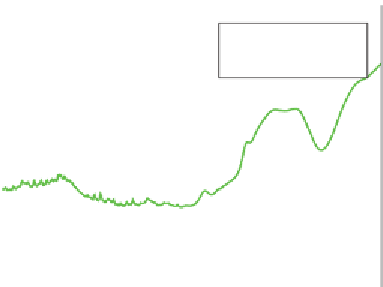Environmental Engineering Reference
In-Depth Information
0,40
BTSE 5%, 2min
BTSE 5%, 5 min
BTSE 5%, 10 min
0,35
0,30
3
0,25
2
0,20
1
0,15
0,10
0,05
0,00
1800
1600
1400
1200
1000
800
Wavenumber (cm
-1
)
Figure 2.18
FTIR spectra of bis-3-(triethoxysilyl) ethane i lm on TSA anodized AA 2024.
1
- BTSE 5%, 2 min conversion, drying at 100
°
C, 5 min;
2
- BTSE 5%, 5 min conversion,
drying at 100
°
C, 5 min;
3
- PSS 5%, 10 min conversion, drying at 100
°
C, 5 min.
to the layer density). In the case of conversion with BTSE and PSS 2%,
it can be noticed that the treatment time has nearly no inl uence on the
-Si-O-Si- peak intensity when compared with BTSE and PSS 5%, where
from the spectra the peak intensity has an increase proportional with the
conversion time.
2.6 Conclusions
It has been demonstrated that the silane mixture of bis-amino silane/bis-sul-
fur silane shows superior corrosion resistance properties when applied on
the aluminium surface compared to a mixture of bis-amino silane/VTAS
or only BTSE and bis-sulfur silane, respectively. A small volume of bis-
amino silanes is sui cient to generate hydrophilic properties on the sur-
face and to support the formation of a homogenous surface i lm on the
anodized AA 2024 sample. On the other hand, a large portion of bis-sulfur
silane enhances the hydrophobicity of the mixture i lm, being the basis for
good protective performance properties of the mixture when applied on
the AA2024 surface. h e mixture of bis-sulfur silane with bis-amino silane
in a ratio of 3:1 showed the highest corrosion resistance on AA 2024-T3.
h e improvement for this mixture is achieved by selectively overcoming
the major drawbacks of the two individual silanes. h e bis-sulfur/bis-amino
mixture enhances the corrosion resistance of aluminium alloys due to the

































Search WWH ::

Custom Search